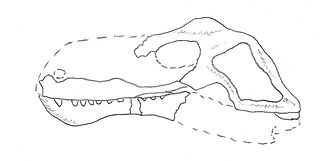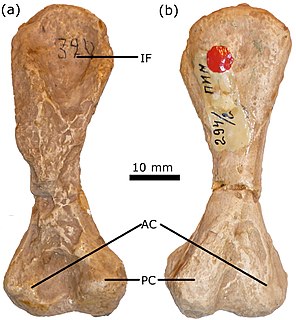
Synapsids are a group of animals that includes mammals and every animal more closely related to mammals than to the other members of the amniote clade, such as reptiles and birds. Unlike other amniotes, they have a temporal fenestra, an opening low in the skull roof behind each eye, leaving a bony arch beneath each; this accounts for their name. Primitive synapsids are usually called pelycosaurs or pelycosaur-grade synapsids. This informal term consists of all synapsids that are not therapsids, a monophyletic, more advanced, mammal-like group. The non-mammalian synapsids were described as mammal-like reptiles in classical systematics, but this misleading terminology is no longer in use as synapsids as a whole are no longer considered reptiles. They are now more correctly referred to as stem mammals or proto-mammals.

Therapsida is a major group of eupelycosaurian synapsids that includes mammals and their ancestors. Many of the traits today seen as unique to mammals had their origin within early therapsids, including limbs that were oriented more underneath the body, as opposed to the sprawling posture of many reptiles and salamanders.

Dimetrodon is an extinct genus of non-mammalian synapsid that lived during the Cisuralian, around 295–272 million years ago (Mya). It is a member of the family Sphenacodontidae. The most prominent feature of Dimetrodon is the large neural spine sail on its back formed by elongated spines extending from the vertebrae. It walked on four legs and had a tall, curved skull with large teeth of different sizes set along the jaws. Most fossils have been found in the Southwestern United States, the majority coming from a geological deposit called the Red Beds of Texas and Oklahoma. More recently, fossils have been found in Germany. Over a dozen species have been named since the genus was first erected in 1878.

The pelycosaurs were previously considered an order, but are now only an informal grouping composed of basal or primitive Late Paleozoic synapsids, formerly called mammal-like reptiles. They consist of all synapsids excluding the therapsids and their descendants.

Biarmosuchia is an extinct clade of non-mammalian synapsids from the Permian. Biarmosuchians are the most basal group of the therapsids. They were moderately-sized, lightly-built carnivores, intermediate in form between basal sphenacodont "pelycosaurs" and more advanced therapsids. Biarmosuchians were rare components of Permian ecosystems, and the majority of species belong to the clade Burnetiamorpha, which are characterized by elaborate cranial ornamentation.

Tetraceratops insignis is an extinct synapsid from the Early Permian that may be the first known representative of Therapsida, a group that includes mammals and their close extinct relatives. It is known from a single 90-millimetre-long (3.5 in) skull, discovered in Texas in 1908. According to a 2020 study, it should be classified as a primitive non-therapsid sphenacodont rather than a genuine basal therapsid.
Caseoides is an extinct genus of large caseid synapsids that lived in the Kungurian Age. It was about 3 metres (9.8 ft) long, and like many other caseids, it was herbivorous and aquatic. It weighed between 150 to 200 kilograms. Its fossils were found in San Angelo Formation, Texas. Caseoides was very similar to Casea, but was slightly larger in size. Caseoides was a heavily built creature, as are most of the Caseids. In the development of its proportionally thick, stout limbs it represents the culmination of the Casea lineage. Its relatives became smaller in size during the Roadian Age. Only poorly preserved postcranial material is known including limbs.
Casea is an extinct genus of medium to large-bodied, herbivorous, pelycosaur synapsids from the late Carboniferous until the middle Permian. The name Casea references its appearance from the Caseasauria which developed new morphology of their external naris and snout. Casea were known to be about 1.2 meters long. It weighed between 150 kg to 200 kg. It was slightly smaller than the otherwise very similar Caseoides. Casea was one of the first amniote herbivores, sharing its world with animals such as Dimetrodon and Eryops. It was possibly also aquatic.

Steppesaurus is an extinct genus of basal Eupelycosauria belonging to the Sphenacodontidae, related to Dimetrodon and Sphenacodon, from the Late Permian San Angelo Formation of Texas.

Aerosaurus is an extinct genus within Varanopidae, a family of non-mammalian synapsids. It lived between 252-299 million years ago during the Early Permian in North America. The name comes from Latin aes (aeris) “copper” and Greek sauros “lizard,” for El Cobre Canyon in northern New Mexico, where the type fossil was found and the site of former copper mines. Aerosaurus was a small to medium-bodied carnivorous synapsid characterized by its recurved teeth, triangular lateral temporal fenestra, and extended teeth row. Two species are recognized: A. greenleeorum (1937) and A. wellesi (1981).

Dimacrodon is an extinct genus of non-mammalian synapsid from the latest Early Permian San Angelo Formation of Texas. It is distinguished by toothless, possibly beaked jaw tips, large lower canines and a thin bony crest on top of its head. Previously thought to be an anomodont therapsid related to dicynodonts, it was later found to lack any diagnostic features of anomodonts or even therapsids and instead appears to be a 'pelycosaur'-grade synapsid of uncertain classification.
Eosyodon is a dubious genus of extinct non-mammalian synapsids from the Permian of Texas. Its type and only species is Eosyodon hudsoni. Though it was originally interpreted as an early therapsid, it is probably a member of Sphenacodontidae, the family of synapsids that includes Dimetrodon.
Elliotsmithia is a small varanopid synapsid found from the late Middle Permian of South Africa. It is the sole basal synapsid "pelycosaur" known from the supercontinent Gondwana and only two specimens have been yielded to date. Its species name longiceps is derived from Latin, meaning "long head". Both known Elliotsmithia fossils were recovered from Abrahamskraal Formation rocks—within the boundaries of the Tapinocephalus Assemblage Zone—of the lower Beaufort Group.

Phreatophasma is an extinct genus of synapsids from the Middle Permian of European Russia. It includes only one species, Phreatophasma aenigmatum, which is itself known from a single femur found in a mine near the town of Belebei in Bashkortostan. Phreatophasma comes from a fossil assemblage that is latest Ufimian to earliest Kazanian in age under the Russian stratigraphic scheme, correlating with the Roadian Age under the international stratigraphic timescale. Because the species is based on a single specimen with few diagnostic anatomical features, uncertainty remains as to where it belongs in tetrapod phylogeny; originally interpreted in 1954 as an enigmatic "theromorph" synapsid by Soviet paleontologist Ivan Yefremov, Phreatophasma was later described as a therapsid incertae sedis by American paleontologist Alfred Romer in 1956 and then as a member of a basal synapsid family called Caseidae starting with Everett C. Olson in 1962. Olson's classification was later supported by Canadian paleontologist Robert Reisz in 1986 and American paleontologist Robert L. Carroll in 1988. Ivakhneneko et al. (1997) and Maddin et al. (2008) both considered Phreatophasma an indeterminate synapsid.
Watongia is an extinct genus of non-mammalian synapsids from Middle Permian of Oklahoma. Only one species has been described, Watongia meieri, from the Chickasha Formation. It was assigned to family Gorgonopsidae by Olson and to Eotitanosuchia by Carroll. Reisz and collaborators assigned the genus in Varanopidae.

Raranimus is an extinct genus of therapsids of the Middle Permian. It was described in 2009 from a partial skull found in 1998 from the Dashankou locality of the Xidagou Formation, outcropping in the Qilian Mountains of Gansu, China. The genus is the most basal known member of the clade Therapsida, to which the later Mammalia belong.
Olson's Extinction was a mass extinction that occurred 273 million years ago in the early Guadalupian of the Permian period and which predated the Permian–Triassic extinction event. It is named after Everett C. Olson. There was a hiatus and a sudden change in between the early Permian and middle/late Permian faunas. Since then this event has been realized across many groups, including plants, marine invertebrates, and tetrapods.
Gorgodon is an extinct genus of basal synapsids. The genus is monotypic, known only from the type species Gorgodon minutus from the Early Permian of the southwestern United States. The only known remains of Gorgodon are two fossils consisting of fragments of the skull. Gorgodon was described and named by paleontologist Everett C. Olson in 1962 from the San Angelo Formation in Knox County, Texas. Based on what is known of Gorgodon—the squamosal, quadrate, and pterygoid bones of the back of the skull, the maxilla and premaxilla bones that make up the front of the skull, and several teeth—Gorgodon had a relatively large temporal fenestra and a pair large, conical caniniform teeth at the front of the jaw. Other distinguishing features of Gorgodon include the fused connection between the quadrate and squamosal bones and a long transverse process of the pterygoid.
The San Angelo Formation is a geologic formation in Texas. It preserves fossils dating back to the Permian period. It is one of the geologically youngest formations to preserve fossils of pelycosaurs.















